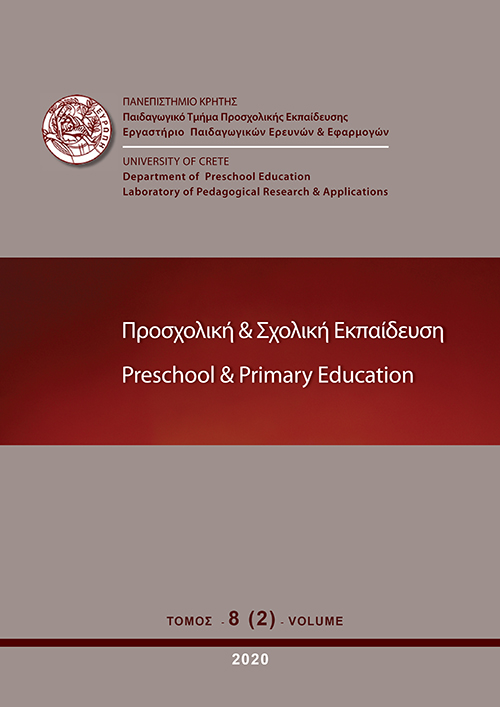Let them shine: insights from an outdoor education initiative for primary school students about an olive tree collection
Περίληψη
Nowadays, experiential learning and outdoor education are increasingly relevant due to phenomena of ‘extinction of experience’ (Pyle, 1993), ’plant blindness’ (Wandersee & Schussler, 2001) and ‘nature deficit childhoods’ (Louv, 2005). This paper revisits experiential learning and outdoor education concepts and some of their development history for European and North American contexts. It highlights plant biodiversity as an important issue for outdoor education due to current risks of biodiversity loss/erosion within agriculture (Linos, et al., 2014; Mousavi et al., 2017).
It describes an experiential learning initiative held in Portugal, in 2019, at an olive tree collection (Olea europaea L.) planted for a research project during the 1980s-1990s.
The initiative was structured with outdoor visits as a complement to classroom learning. It engaged five teachers and 117 students, aged 8-9 years. Data from students and teachers questionnaires results are evaluated as a way to counteract the above phenomena and to benefit children training. Existing research indicates the role of provision of supportive and stimulating environmental conditions during childhood to strengthen individual competencies to make decisions able to accelerate transition for more sustainable societies (U.N., 2019). This paper results articulates with existing research and can be useful to inform effective outdoor programme design.
Λεπτομέρειες άρθρου
- Πώς να δημιουργήσετε Αναφορές
-
Lima, M. A. A. (2020). Let them shine: insights from an outdoor education initiative for primary school students about an olive tree collection. Preschool and Primary Education, 8(2), 130–143. https://doi.org/10.12681/ppej.21988
- Τεύχος
- Τόμ. 8 Αρ. 2 (2020)
- Ενότητα
- Άρθρα

Αυτή η εργασία είναι αδειοδοτημένη υπό το CC Αναφορά Δημιουργού – Μη Εμπορική Χρήση – Παρόμοια Διανομή 4.0.
Οι συγγραφείς των άρθρων που δημοσιεύονται στο ΠΡΟΣΧΟΛΙΚΗ & ΣΧΟΛΙΚΗ ΕΚΠΑΙΔΕΥΣΗ διατηρούν τα δικαιώματα πνευματικής ιδιοκτησίας επί των άρθρων τους, δίνοντας στο περιοδικό το δικαίωμα της πρώτης δημοσίευσης. Άρθρα που δημοσιεύονται στο ΠΡΟΣΧΟΛΙΚΗ & ΣΧΟΛΙΚΗ ΕΚΠΑΙΔΕΥΣΗ διατίθενται με άδεια Creative Commons 3.0 και σύμφωνα με την άδεια μπορούν να χρησιμοποιούνται ελεύθερα, με αναφορά στο/στη συγγραφέα και στην πρώτη δημοσίευση για μη κερδοσκοπικούς σκοπούς και με δικαίωμα τροποποίησης μόνον με παρόμοια διανομή (αν αναμείξετε, τροποποιήσετε, ή δημιουργήσετε πάνω στο υλικό, πρέπει να διανείμετε τις δικές σας συνεισφορές υπό την ίδια άδεια όπως και το πρωτότυπο). To Εργαστήριο Παιδαγωγικών Ερευνών και Εφαρμογών του Παιδαγωγικού Τμήματος Προσχολικής Εκπαίδευσης του Πανεπιστημίου Κρήτης και το Εθνικό Κέντρο Τεκμηρίωσης διατηρούν το δικαίωμα να δημοσιεύουν, να αναπαραγάγουν, να παρουσιάζουν στο κοινό, να διανέμουν και χρησιμοποιούν άρθρα που δημοσιεύονται στο ΠΡΟΣΧΟΛΙΚΗ & ΣΧΟΛΙΚΗ ΕΚΠΑΙΔΕΥΣΗ σε οποιοδήποτε μέσο και μορφή είτε μεμονωμένα είτε ως μέρη συλλογικών έργων, για όλο το χρόνο διάρκειας προστασίας της πνευματικής ιδιοκτησίας και για όλες τις χώρες του κόσμου. Αυτό περιλαμβάνει ενδεικτικά και όχι αποκλειστικά, το δικαίωμα δημοσίευσης των άρθρων σε τεύχη του περιοδικού ΠΡΟΣΧΟΛΙΚΗ & ΣΧΟΛΙΚΗ ΕΚΠΑΙΔΕΥΣΗ, αναπαραγωγής και διανομής μεμονωμένων αντιγράφων των άρθρων, αναπαραγωγής ολόκληρων των άρθρων σε άλλη έκδοση του Εργαστηρίου Παιδαγωγικών Ερευνών και Εφαρμογών του Παιδαγωγικού Τμήματος Προσχολικής Εκπαίδευσης του Πανεπιστημίου Κρήτης και του Εθνικού Κέντρου Τεκμηρίωσης και αναπαραγωγής και διανομής των άρθρων ή περίληψης αυτών με χρήση πληροφορικού συστήματος αποθετηρίου.



